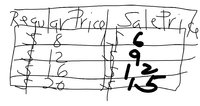eddy2017
Elite Member
- Joined
- Oct 27, 2017
- Messages
- 2,525
Hi, sorry for the mix-up.
I have this problem.
Which algebraic expression can be used to determine the sales price. Use the following table.
I am attaching the table here.
I'm studying finding relations from a table and trying to get the hang of it.
This is what i have been able to do from i have studied so far.
I will assign x and y values to the table.
Regular price= x
Sale price= y
Now, I see what is going on with both x and y
X increases by 1
While y also increases by 3.
In other words I am adding 3 to the first number on the y section.
So a possible equation that I could write taking this analysis would be:
I am stuck in how to start writing the equation.
Thanks in advance for any hints.
eddy
I have this problem.
Which algebraic expression can be used to determine the sales price. Use the following table.
I am attaching the table here.
I'm studying finding relations from a table and trying to get the hang of it.
This is what i have been able to do from i have studied so far.
I will assign x and y values to the table.
Regular price= x
Sale price= y
Now, I see what is going on with both x and y
X increases by 1
While y also increases by 3.
In other words I am adding 3 to the first number on the y section.
So a possible equation that I could write taking this analysis would be:
I am stuck in how to start writing the equation.
Thanks in advance for any hints.
eddy
Attachments
Last edited:

